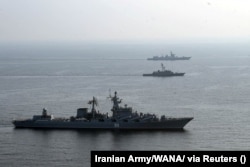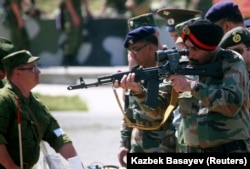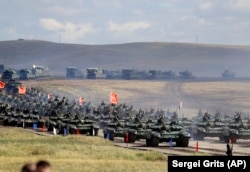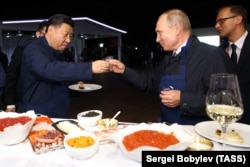When Russia last launched its Vostok war games in its Far East in 2018, an estimated 300,000 of its troops exercised with Chinese and Mongolian soldiers as the Kremlin sought to project an image of military superiority and showcase deepening ties with Beijing.
As Moscow now prepares for another round of the drills, only a fraction of that previous total -- 50,000 personnel -- will take part in a series of exercises as Russia looks to demonstrate that its military capabilities are still intact despite the growing cost and strain from its invasion of Ukraine.
The weeklong war games will kick off on September 1 and involve forces from China, India, Laos, Mongolia, Nicaragua, Algeria, Syria, as well as military personnel from Belarus, Kazakhstan, Kyrgyzstan, and Tajikistan.
The drills will involve various maneuvers by air, land, and sea, with Russia saying that its Pacific Fleet and China's navy would take part in "joint practical actions to defend maritime communications and areas of maritime economic activity" in the Sea of Japan.
While Russian defense officials have said that the exercises are purely defensive and not directed toward any particular country, they remain draped in symbolism amid Moscow’s ongoing war in Ukraine and simmering geopolitical tensions in Asia.
Experts and defense analysts say they will be closely watched by regional powers such as Japan and South Korea, particularly as Russia and China continue to show their growing political and military ties and a joint attention on the Pacific.
“This is a good opportunity for China to work with Russia with their shared focus on Japan,” Haiyun Ma, a professor at Frostburg State University in Maryland who studies Beijing's relations with Russia and Central and South Asian countries, told RFE/RL. “With tensions rising over the Taiwan Strait, Japan is really in [Beijing’s] sights these days and they are hoping that Russia can be closer to them in the Pacific.”
The participation of India has also added another layer of intrigue to the war games.
New Delhi has longstanding defense ties to Moscow but also strong relations with Washington. China and India are in the midst of a border dispute in the Himalayas that sparked a deadly clash only two years ago, and the Indians are preparing for military exercises with the United States near the Chinese border in October.
“Russia has become very toxic in the international community, but these exercises allow it to get back to the [message] it was trying to send before the Ukraine war,” Temur Umarov, a fellow at the Moscow Carnegie Center, told RFE/RL. “Russia wants to keep building up its defense ties and show that the war hasn’t left it completely isolated.”
An Eastern Focus
Chinese and Russian forces have been regularly doing drills together in some form since 2005, but those have expanded in recent years to include naval exercises in Asia and the Mediterranean.
In 2018, Beijing and Moscow moved to larger-scale exercises that focused on training top-level commanders to work together, and last year Russian troops deployed to Chinese territory for exercises for the first time.
These close-knit ties culminated in what Chinese leader Xi Jinping and Russian President Vladimir Putin declared as a “no limits” partnership between their countries in February before Moscow invaded Ukraine.
Since the invasion, China has tread carefully to avoid violating Western sanctions against Russia but has blamed NATO and Western “provocation” for the war in Ukraine, backed Moscow diplomatically at international organizations, and both countries flew nuclear-capable bombers over the Sea of Japan in May as U.S. President Joe Biden attended a summit in Tokyo.
Russia has also backed Beijing amid tensions with Taiwan and Washington over a visit by U.S. House of Representatives speaker Nancy Pelosi to Taipei. In response to Pelosi’s trip, China held live-fire drills near Taiwan and launched five ballistic missiles that landed in Japan’s exclusive economic zone.
Chinese officials stressed earlier this month that Beijing’s participation in the Russian war games was “unrelated to the current international and regional situation,” although Ma says that recent changes in Japanese policy -- such as increased defense spending, Japanese sanctions against Moscow, and criticism from Tokyo over China’s actions toward Taiwan -- have inflamed tensions.
He notes that in a show of strength last week, two Russian naval convoys passed through the La Perouse Strait that separates Russia and Japan en route to the Vostok exercises.
Both China and Russia have territorial disputes with Japan, with Moscow and Tokyo both claiming the Kuril Islands and Japan administering the uninhabited islets known as the Senkakus, which are also claimed by Beijing and Taipei.
The India Factor
India’s involvement in the drills, especially given the participation of China, has confounded some observers as tensions between Beijing and New Delhi continue to rise and India continues to build up its ties with the West.
On August 29, India accused China of the “militarization of the Taiwan Strait” as the two traded barbs following an earlier dispute over a Chinese military ship docking in a controversial Sri Lankan port.
Nevertheless, analysts say India’s friendly ties with Moscow -- which are centered around a deep defense relationship -- have led to its participation in the exercises.
“The optics from a Western perspective might not be good, but this serves Indian foreign policy in a big way,” Michael Kugelman, deputy director of the Asia Program at the Wilson Center, told RFE/RL.
India has so far refrained from condemning Russia's invasion and has continued to purchase cheap Russian oil, ignoring Western efforts to isolate Moscow.
Kugelman says the military exercises fit within India’s foreign policy of “strategic autonomy” where it seeks to balance between competing powers and pursue its own interests.
India also belongs to several multilateral blocs that include both Russia and China -- from the BRICS with Brazil and South Africa to the Shanghai Cooperation Organization with Pakistan and Central Asian countries. Kugelman says these diverse partnerships allow New Delhi to build regional clout and avoid being boxed in by other countries; rivalries.
“This serves India well and allows it to showcase its flexibility and ability to balance rival countries,” he said.













